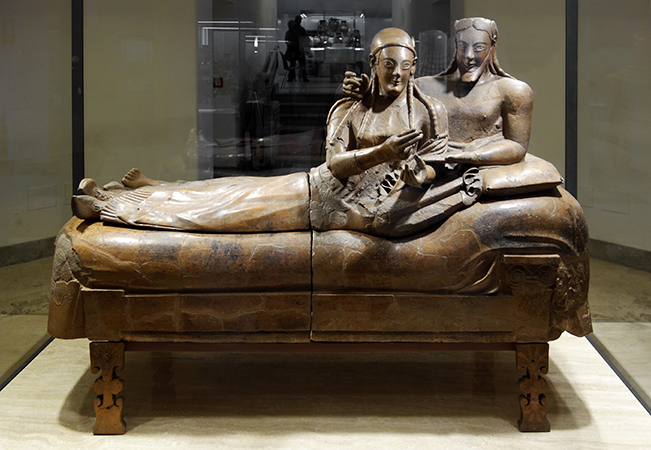Charly Castillo
Charly Castillo
AP Art History 🖼
34 resourcesSee Units
Etruria (900-270 BCE)
Architecture
- Buildings are made from wood and mud brick, which is why many of them have not been preserved over the centuries 🏚️
- Etruscan architects built stairs that led to an entrance, unlike Greek architects who surrounded a building with stairs
- Inspired by Greek architecture (columns, capitals, built on an elevated platform 🏛️, etc)

Image Courtesy of Khan Academy. Temple of Minerva.
Painting
- Men are painted in darker colors than women, which Etruscan paintings have in common with ones made in ancient Egypt.
- Most frescoes (method of painting where the artist applies paint 🖌️ on top of fresh plaster) are found in tombs, which shows that they had a funerary purpose in Etruria.

Image Courtesy of Bethany H on Pinterest. Tomb of the Triclinium.
Sculpture
- Sculptures are commonly made from terracotta (ceramic made from clay) or stucco (a type of plaster usually made from sand, lime, and water).
- Figures are always clothed for modesty, unlike most Greek sculptures.
- Were once brightly painted 🎨, but it has worn away with time and only the terracotta bases remain

Image Courtesy of Khan Academy. Sarcophagus of the Spouses.
Browse Study Guides By Unit
🗿Unit 1 – Global Prehistoric Art, 30,000-500 BCE
🏛Unit 2 – Ancient Mediterranean Art, 3500-300 BCE
⛪️Unit 3 – Early European and Colonial American Art, 200-1750 CE
⚔️Unit 4 – Later European and American Art, 1750-1980 CE
🌽Unit 5 – Indigenous American Art, 1000 BCE-1980 CE
⚱️Unit 6 – African Art, 1100-1980 CE
🕌Unit 7 – West and Central Asian Art, 500 BCE-1980 CE
🛕Unit 8 – South, East, and Southeast Asian Art, 300 BCE-1980 CE
🐚Unit 9: The Pacific, 700–1980 ce
🏢Unit 10 – Global Contemporary Art, 1980 CE to Present
🙏Exam Reviews

© 2023 Fiveable Inc. All rights reserved.